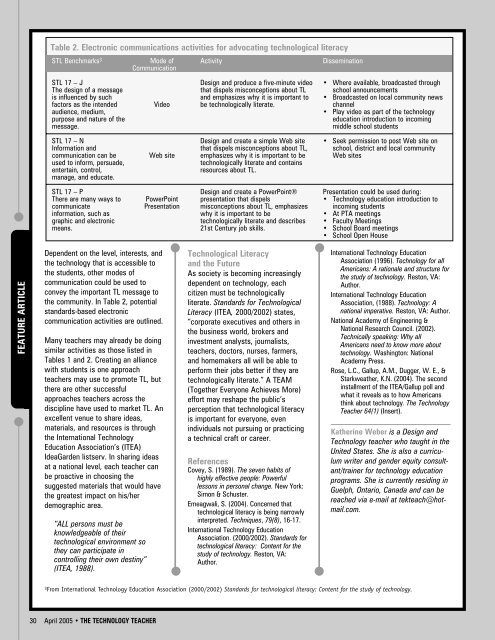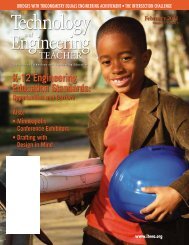Teaching Elements and Principles of Bridge Design - International ...
Teaching Elements and Principles of Bridge Design - International ...
Teaching Elements and Principles of Bridge Design - International ...
Create successful ePaper yourself
Turn your PDF publications into a flip-book with our unique Google optimized e-Paper software.
Table 2. Electronic communications activities for advocating technological literacy<br />
STL Benchmarks 3<br />
Mode <strong>of</strong><br />
Communication<br />
Activity<br />
Dissemination<br />
STL 17 – J<br />
The design <strong>of</strong> a message<br />
is influenced by such<br />
factors as the intended<br />
audience, medium,<br />
purpose <strong>and</strong> nature <strong>of</strong> the<br />
message.<br />
Video<br />
<strong>Design</strong> <strong>and</strong> produce a five-minute video<br />
that dispels misconceptions about TL<br />
<strong>and</strong> emphasizes why it is important to<br />
be technologically literate.<br />
• Where available, broadcasted through<br />
school announcements<br />
• Broadcasted on local community news<br />
channel<br />
• Play video as part <strong>of</strong> the technology<br />
education introduction to incoming<br />
middle school students<br />
STL 17 – N<br />
Information <strong>and</strong><br />
communication can be<br />
used to inform, persuade,<br />
entertain, control,<br />
manage, <strong>and</strong> educate.<br />
Web site<br />
<strong>Design</strong> <strong>and</strong> create a simple Web site<br />
that dispels misconceptions about TL,<br />
emphasizes why it is important to be<br />
technologically literate <strong>and</strong> contains<br />
resources about TL.<br />
• Seek permission to post Web site on<br />
school, district <strong>and</strong> local community<br />
Web sites<br />
STL 17 – P<br />
There are many ways to<br />
communicate<br />
information, such as<br />
graphic <strong>and</strong> electronic<br />
means.<br />
PowerPoint<br />
Presentation<br />
<strong>Design</strong> <strong>and</strong> create a PowerPoint®<br />
presentation that dispels<br />
misconceptions about TL, emphasizes<br />
why it is important to be<br />
technologically literate <strong>and</strong> describes<br />
21st Century job skills.<br />
Presentation could be used during:<br />
• Technology education introduction to<br />
incoming students<br />
• At PTA meetings<br />
• Faculty Meetings<br />
• School Board meetings<br />
• School Open House<br />
FEATURE ARTICLE<br />
Dependent on the level, interests, <strong>and</strong><br />
the technology that is accessible to<br />
the students, other modes <strong>of</strong><br />
communication could be used to<br />
convey the important TL message to<br />
the community. In Table 2, potential<br />
st<strong>and</strong>ards-based electronic<br />
communication activities are outlined.<br />
Many teachers may already be doing<br />
similar activities as those listed in<br />
Tables 1 <strong>and</strong> 2. Creating an alliance<br />
with students is one approach<br />
teachers may use to promote TL, but<br />
there are other successful<br />
approaches teachers across the<br />
discipline have used to market TL. An<br />
excellent venue to share ideas,<br />
materials, <strong>and</strong> resources is through<br />
the <strong>International</strong> Technology<br />
Education Association’s (ITEA)<br />
IdeaGarden listserv. In sharing ideas<br />
at a national level, each teacher can<br />
be proactive in choosing the<br />
suggested materials that would have<br />
the greatest impact on his/her<br />
demographic area.<br />
“ALL persons must be<br />
knowledgeable <strong>of</strong> their<br />
technological environment so<br />
they can participate in<br />
controlling their own destiny”<br />
(ITEA, 1988).<br />
Technological Literacy<br />
<strong>and</strong> the Future<br />
As society is becoming increasingly<br />
dependent on technology, each<br />
citizen must be technologically<br />
literate. St<strong>and</strong>ards for Technological<br />
Literacy (ITEA, 2000/2002) states,<br />
“corporate executives <strong>and</strong> others in<br />
the business world, brokers <strong>and</strong><br />
investment analysts, journalists,<br />
teachers, doctors, nurses, farmers,<br />
<strong>and</strong> homemakers all will be able to<br />
perform their jobs better if they are<br />
technologically literate.” A TEAM<br />
(Together Everyone Achieves More)<br />
effort may reshape the public’s<br />
perception that technological literacy<br />
is important for everyone, even<br />
individuals not pursuing or practicing<br />
a technical craft or career.<br />
References<br />
Covey, S. (1989). The seven habits <strong>of</strong><br />
highly effective people: Powerful<br />
lessons in personal change. New York:<br />
Simon & Schuster.<br />
Emeagwali, S. (2004). Concerned that<br />
technological literacy is being narrowly<br />
interpreted. Techniques, 79(8), 16-17.<br />
<strong>International</strong> Technology Education<br />
Association. (2000/2002). St<strong>and</strong>ards for<br />
technological literacy: Content for the<br />
study <strong>of</strong> technology. Reston, VA:<br />
Author.<br />
<strong>International</strong> Technology Education<br />
Association (1996). Technology for all<br />
Americans: A rationale <strong>and</strong> structure for<br />
the study <strong>of</strong> technology. Reston, VA:<br />
Author.<br />
<strong>International</strong> Technology Education<br />
Association, (1988). Technology: A<br />
national imperative. Reston, VA: Author.<br />
National Academy <strong>of</strong> Engineering &<br />
National Research Council. (2002).<br />
Technically speaking: Why all<br />
Americans need to know more about<br />
technology. Washington: National<br />
Academy Press.<br />
Rose, L.C., Gallup, A.M., Dugger, W. E., &<br />
Starkweather, K.N. (2004). The second<br />
installment <strong>of</strong> the ITEA/Gallup poll <strong>and</strong><br />
what it reveals as to how Americans<br />
think about technology. The Technology<br />
Teacher 64(1) (Insert).<br />
Katherine Weber is a <strong>Design</strong> <strong>and</strong><br />
Technology teacher who taught in the<br />
United States. She is also a curriculum<br />
writer <strong>and</strong> gender equity consultant/trainer<br />
for technology education<br />
programs. She is currently residing in<br />
Guelph, Ontario, Canada <strong>and</strong> can be<br />
reached via e-mail at tekteach@hotmail.com.<br />
3 From <strong>International</strong> Technology Education Association (2000/2002) St<strong>and</strong>ards for technological literacy: Content for the study <strong>of</strong> technology.<br />
30 April 2005 • THE TECHNOLOGY TEACHER
















